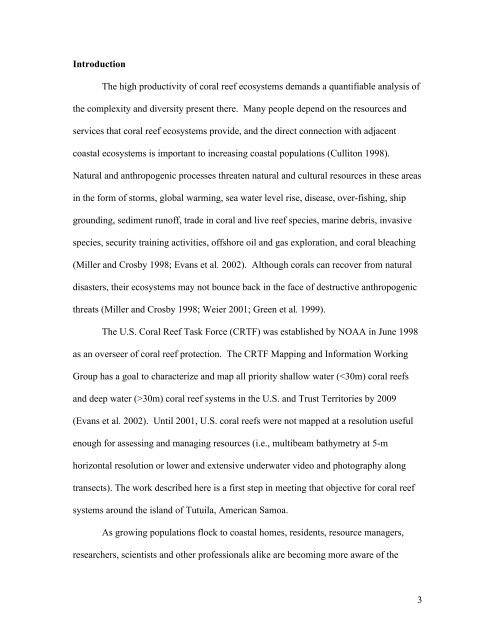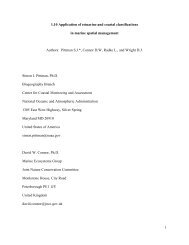A Benthic Terrain Classification Scheme for American Samoa
A Benthic Terrain Classification Scheme for American Samoa
A Benthic Terrain Classification Scheme for American Samoa
You also want an ePaper? Increase the reach of your titles
YUMPU automatically turns print PDFs into web optimized ePapers that Google loves.
Introduction<br />
The high productivity of coral reef ecosystems demands a quantifiable analysis of<br />
the complexity and diversity present there. Many people depend on the resources and<br />
services that coral reef ecosystems provide, and the direct connection with adjacent<br />
coastal ecosystems is important to increasing coastal populations (Culliton 1998).<br />
Natural and anthropogenic processes threaten natural and cultural resources in these areas<br />
in the <strong>for</strong>m of storms, global warming, sea water level rise, disease, over-fishing, ship<br />
grounding, sediment runoff, trade in coral and live reef species, marine debris, invasive<br />
species, security training activities, offshore oil and gas exploration, and coral bleaching<br />
(Miller and Crosby 1998; Evans et al. 2002). Although corals can recover from natural<br />
disasters, their ecosystems may not bounce back in the face of destructive anthropogenic<br />
threats (Miller and Crosby 1998; Weier 2001; Green et al. 1999).<br />
The U.S. Coral Reef Task Force (CRTF) was established by NOAA in June 1998<br />
as an overseer of coral reef protection. The CRTF Mapping and In<strong>for</strong>mation Working<br />
Group has a goal to characterize and map all priority shallow water (30m) coral reef systems in the U.S. and Trust Territories by 2009<br />
(Evans et al. 2002). Until 2001, U.S. coral reefs were not mapped at a resolution useful<br />
enough <strong>for</strong> assessing and managing resources (i.e., multibeam bathymetry at 5-m<br />
horizontal resolution or lower and extensive underwater video and photography along<br />
transects). The work described here is a first step in meeting that objective <strong>for</strong> coral reef<br />
systems around the island of Tutuila, <strong>American</strong> <strong>Samoa</strong>.<br />
As growing populations flock to coastal homes, residents, resource managers,<br />
researchers, scientists and other professionals alike are becoming more aware of the<br />
3
















